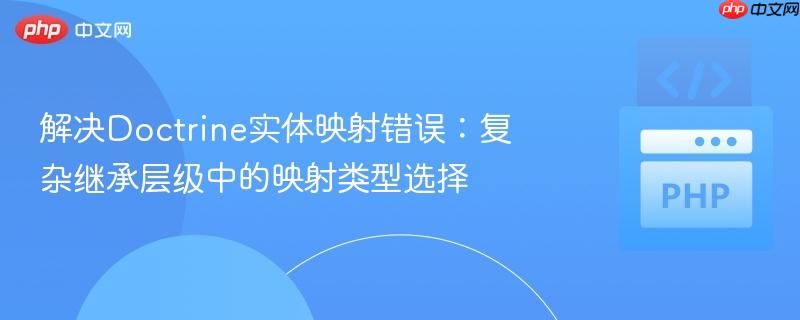
本文深入探讨了在Doctrine ORM中处理复杂实体继承层级时,因映射类型配置不当(特别是PHP 8+属性与旧版注解的混淆)导致的实体识别问题。通过分析常见错误“Class "..." is not a valid entity or mapped super class”,文章明确指出了将映射类型从`annotation`更改为`attribute`的解决方案,并提供了详细的配置示例和最佳实践,旨在帮助开发者正确配置Doctrine映射,确保实体层级结构的有效识别。
在Doctrine ORM中,实体(Entity)是数据库表的映射,而映射超类(Mapped Superclass)则提供了一个共享的字段和映射定义,但不对应独立的数据库表。当构建复杂的应用时,我们经常会遇到实体继承的场景,例如一个基类定义通用属性,而子类则扩展这些属性并可能对应不同的业务逻辑。
考虑以下实体层级结构:
这种结构允许代码复用和清晰的领域模型划分。在PHP 8及更高版本中,我们通常使用PHP属性(Attributes)来定义Doctrine映射,例如#[ORM\Entity]和#[ORM\MappedSuperclass]。
// in main project src/Entity
namespace App\Entity;
use Doctrine\ORM\Mapping as ORM;
use XyBundle\Entity\Content\AbstractArticle;
#[ORM\Entity]
class Article extends AbstractArticle
{
// ... specific Article properties and methods
}// in bundle src/Entity/Content
namespace XyBundle\Entity\Content;
use Doctrine\ORM\Mapping as ORM;
use XyBundle\Entity\AbstractEntity;
// use NormalizableInterface, EntityInterface; // Assuming these are external interfaces
#[ORM\MappedSuperclass]
abstract class AbstractArticle extends AbstractEntity // implements NormalizableInterface
{
// ... common AbstractArticle properties and methods
}// in bundle src/Entity
namespace XyBundle\Entity;
use Doctrine\ORM\Mapping as ORM;
// use NormalizableInterface, EntityInterface; // Assuming these are external interfaces
#[ORM\MappedSuperclass]
abstract class AbstractEntity // implements NormalizableInterface, EntityInterface
{
// ... common AbstractEntity properties and methods
}当上述实体层级存在时,如果Doctrine配置中的映射类型与实体定义中使用的映射方式不匹配,就会出现问题。一个常见的错误配置示例如下:
# config/packages/doctrine.yaml
orm:
auto_generate_proxy_classes: true
naming_strategy: doctrine.orm.naming_strategy.underscore_number_aware
auto_mapping: true
mappings:
App:
is_bundle: false
type: annotation # 注意这里使用了 'annotation'
dir: '%kernel.project_dir%/src/Entity'
prefix: 'App\Entity'
alias: App
XyBundle:
is_bundle: true
type: annotation # 注意这里也使用了 'annotation'
dir: 'Entity'
prefix: 'XyBundle\Entity'
alias: Xy在这种配置下,尽管实体代码中使用了PHP 8+的属性#[ORM\Entity]和#[ORM\MappedSuperclass],但Doctrine却被告知要查找基于旧版DocBlock注解(如@ORM\Entity)的映射。这种不匹配会导致Doctrine无法正确识别实体,从而抛出类似以下错误:
Class "App\Entity\Article" sub class of "XyBundle\Entity\Content\AbstractArticle" is not a valid entity or mapped super class.
这个错误明确指出,Doctrine无法将App\Entity\Article或其父类XyBundle\Entity\Content\AbstractArticle识别为有效的实体或映射超类。根本原因在于,Doctrine尝试解析App\Entity\Article时,发现它继承自XyBundle\Entity\Content\AbstractArticle,但后者在当前配置(type: annotation)下无法被正确解析为映射超类,进而导致整个继承链条的验证失败。
解决此问题的关键在于确保Doctrine配置中的映射类型与实体定义中实际使用的映射方式保持一致。由于我们在PHP 8+环境中使用的是#[ORM\]属性,因此需要将映射类型从annotation更改为attribute。
以下是修正后的Doctrine配置:
# config/packages/doctrine.yaml
orm:
auto_generate_proxy_classes: true
naming_strategy: doctrine.orm.naming_strategy.underscore_number_aware
auto_mapping: true
mappings:
App:
is_bundle: false
type: attribute # 关键更改:从 annotation 改为 attribute
dir: '%kernel.project_dir%/src/Entity'
prefix: 'App\Entity'
alias: App
XyBundle:
is_bundle: true
type: attribute # 关键更改:从 annotation 改为 attribute
dir: 'Entity'
prefix: 'XyBundle\Entity'
alias: Xy将type设置为attribute后,Doctrine将正确地解析PHP 8+属性,从而能够识别AbstractEntity、AbstractArticle为映射超类,并最终将Article识别为有效的实体。
php bin/console cache:clear
在Doctrine ORM中处理复杂的实体继承层级时,正确配置映射类型是至关重要的。当使用PHP 8+的属性(#[ORM\])来定义实体映射时,务必在doctrine.yaml配置中将mappings的type设置为attribute。忽略这一细节会导致Doctrine无法识别实体或映射超类,从而引发“is not a valid entity or mapped super class”错误。通过理解映射机制并遵循最佳实践,开发者可以确保其实体模型在Doctrine中得到正确且高效的处理。
以上就是解决Doctrine实体映射错误:复杂继承层级中的映射类型选择的详细内容,更多请关注php中文网其它相关文章!

每个人都需要一台速度更快、更稳定的 PC。随着时间的推移,垃圾文件、旧注册表数据和不必要的后台进程会占用资源并降低性能。幸运的是,许多工具可以让 Windows 保持平稳运行。

Copyright 2014-2025 https://www.php.cn/ All Rights Reserved | php.cn | 湘ICP备2023035733号